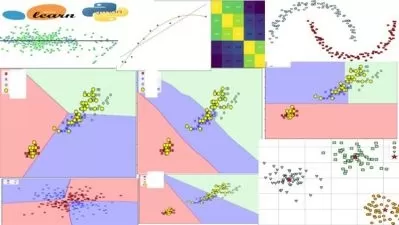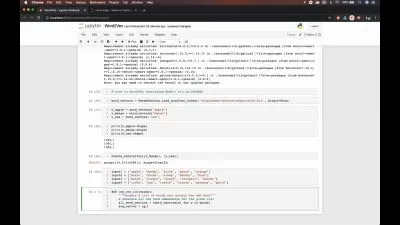Learn Machine Learning & Data Mining with Python
Data Science Guide
8:35:38
Description
Learn Building Machine Learning & Deep Learning Models in Python, and use the Results in Data Mining Analyses
What You'll Learn?
- Learn everything about Data Mining and its applications
- Understand Machine Learning and its connection with Data Mining
- Learn all Machine Learning algorithms, their types, and their usage in business
- Learn how to implement Machine Learning algorithms in different business scenarios
- Learn how to install and use Python programming language to create machine learning algorithms in a simple way
- Learn how to import your data sets into Python and make required cleaning before creating the algorithms
- Learn how to interpret the results of each algorithms and compare them with each other to choose the optimum one
- Learn how to create graphs in Pythons, such as scattered and regression graphs and use them in your analyses
- Learn data analysis in PySpark
Who is this for?
What You Need to Know?
More details
DescriptionIf you seek to learn how to create machine learning models and use them in data mining process, this course is for you. You will understand in this course what is data mining process and how to implement machine learning algorithms in data mining. Moreover, you will learn in details how deep learning does work and how to build a deep learning model to solve a business problem. In the beginning of the course, you will understand the basic concepts of data mining and learn about the business fields where data mining is implemented.
After that you will learn how to create machine learning models in Python using several data science libraries developed especially for this purpose. NumPy, Pandas, and Matplotlib are some examples of these models that you will learn how to import and use to create machine learning algorithms in Python. You will learn typing codes in Python from scratch without the need to have a pervious knowledge in coding. You will be familiar with the essential code needed to build machine learning models. This course is designed to provide you with the knowledge you need in a simple and straightforward way to smooth the learning process. You will build your knowledge step by step until you become familiar with the most used Machine Learning algorithms.Â
Who this course is for:
- Anyone who need to use machine learning algorithms in data mining for business implementation.
- Anyone wants to learn Machine Learning in Python.
- Anyone wants to learn data analysis in PySpark.
If you seek to learn how to create machine learning models and use them in data mining process, this course is for you. You will understand in this course what is data mining process and how to implement machine learning algorithms in data mining. Moreover, you will learn in details how deep learning does work and how to build a deep learning model to solve a business problem. In the beginning of the course, you will understand the basic concepts of data mining and learn about the business fields where data mining is implemented.
After that you will learn how to create machine learning models in Python using several data science libraries developed especially for this purpose. NumPy, Pandas, and Matplotlib are some examples of these models that you will learn how to import and use to create machine learning algorithms in Python. You will learn typing codes in Python from scratch without the need to have a pervious knowledge in coding. You will be familiar with the essential code needed to build machine learning models. This course is designed to provide you with the knowledge you need in a simple and straightforward way to smooth the learning process. You will build your knowledge step by step until you become familiar with the most used Machine Learning algorithms.Â
Who this course is for:
- Anyone who need to use machine learning algorithms in data mining for business implementation.
- Anyone wants to learn Machine Learning in Python.
- Anyone wants to learn data analysis in PySpark.
User Reviews
Rating
Data Science Guide
Instructor's Courses
Udemy
View courses Udemy- language english
- Training sessions 127
- duration 8:35:38
- English subtitles has
- Release Date 2022/11/17








![Python for Signal and Image Processing Master Class [2023]](https://traininghub.ir/image/course_pic/16810-x225.webp)











